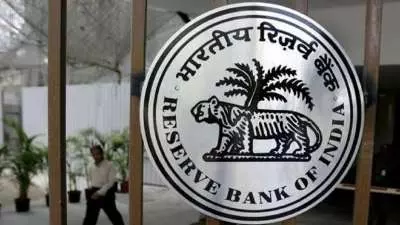RBI to start rate easing cycle from December

Reserve Bank of India. (Photo: X)
Mumbai: The Reserve Bank of India’s (RBI) strong resolve in addressing food price inflation and preventing an un-anchoring in inflationary expectations is likely to see the monetary policy committee (MPC) of the RBI lean towards a pause in October. However, most economists now expect the MPC to start the easing cycle from December policy. The six-member MPC will begin their three-day deliberations from October 7 with the outcome being announced on October 9.
Tanvee Gupta Jain, UBS Chief India Economist said, “Given the domestic inflation outlook is improving (likely to be 30 basis points lower than RBI's forecast of 4.5 per cent for FY25) and global monetary easing cycle has begun, we now expect MPC to lower repo rates by 75 basis points in this cycle (prior forecast was 50bps). That said, the timing of India's rate cut cycle will be dependent on domestic growth-inflation dynamics. In our base case, we expect an easing cycle to start from December policy.”
Madhavi Arora, lead economist at Emkay Global said, “We don’t expect a rate cut in October but possibly a first cut by December because RBI is clearly more focused on inflation at this point of time.”
The US Federal Reserve last week reduced its key interest rate by 50 basis points. In addition, globally central banks including European Central Bank, Bank of England and Indonesia have cut rates, and a rate cut would help maintain India's competitive position in attracting investment and boosting economic growth. However, the RBI governor Shaktikanta Das in several monetary policy conferences have reiterated that the MPC’s decisions are driven by domestic factors. The minutes of the August monetary policy meeting showed that Das rued the fact that while inflation is gradually trending down, its pace is slow and uneven. He said that durable alignment of inflation to the RBI’s target of 4 per cent is still some distance away and spillovers of food inflation to core has to be avoided.
The RBI has hiked policy rates by 250 basis points between May 2022 and February 2023, since then it has kept the repo rate unchanged at 6.5 per cent to align inflation to the 4 per cent target.
So far, the inflation trajectory remains within the RBI’s projections, with Consumer Price Index (CPI) inflation marginally higher at 3.65
per cent year on year compared to 3.6 per cent YoY in the previous month. Food inflation rose to 5.30 per cent YoY in August 2024 from 5.06 per cent in the previous month.
The repo rate is the rate at which the RBI lends money to banks to meet their short-term funding needs. A status quo in repo rate means that all external benchmark lending rates (EBLR) that are linked to the repo rate will remain unchanged providing relief to borrowers.
Radhika Rao, executive director and senior economist, DBS Bank too expects a pause in the October policy. “For India, the US Fed’s
decision is a necessary but not sufficient condition for the RBI monetary policy committee to shift to a dovish gear expeditiously.
More importantly, domestic conditions, primarily the inflation path, besides currency movements and growth impulse, should also warrant a pivot. Add to this, new external members are due to join the policy committee next month, and it would be crucial to gauge their leaning to validate our expectations on the timing of a rate cut cycle,” said Rao.
The contracts of three external members of the MPC will expire on October 4, just days before the MPC is expected to meet and make its rate decision on Oct. 9. Incoming members might prefer to maintain a status quo in October but follow a broader MPC shift in December as more inflation and growth prints become available said Rao.
( Source : Deccan Chronicle )
Next Story

